Rockfield
Houses within 10km of this house
Displaying 52 houses.
Houses within 10km of Rockfield
Displaying 52 houses.
| House name | Description | |
|---|---|---|
| Killorglin Glebe | Rev. Robert Denny was leasing Killorglin Glebe to Rev. William de Moelyns at the time of Griffith’s Valuation, when it was valued at £16. The site now appears to be occupied by agricultural buildings. | |
| Summerhill (Mount Meredith) | In 1786 Wilson refers to Mount Meredith as a gentleman's seat close to Killarney. Bary writes that this is the property that later became known as Summerhill, held by The O’Donoghue. The Ordnance Survey Name Books note that this townland was leased by St. John Mason to Richard McGillycuddy and Madam O'Donoghue in the 1830s. The house is described as "formerly a handsome house but is now suffering to go to ruin". At the time of Griffith’s Valuation it was valued at £3 and leased to James Donovan. A substantial modern farm exists at the site now. | |
| The Reeks or Baunclune | The McGillycuddy was in possession of the property at Whitefield at the time of Griffith’s Valuation when it was valued at £24 10s. Lewis and Leet also refer to Whitefield as a seat of The McGillycuddy in 1837 and 1814 respectively. Leet, however, also notes McGillycuddy Reeks as the address of McGillycuddy esq. In 1906 it was McGillycuddy property and valued at £24. Bary states that the house was originally known as The Reeks after the family title but that it was changed to Whitefield in the early 19th century by Richard McGillycuddy. However, on both the 1st and 25-edition Ordnance Survey maps it is labelled Baunclune. In more recent times it is known as The Reeks. This is how it is referred to by the Irish Tourist Association surveyor in the early 1940s who states that it was the the home of "Ross Kinloch, the MacGillycuddy of the Reeks and a member of Seanad Eireann". The house is still extant and occupied. |
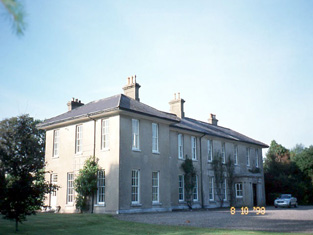
|
| Coolgarriv House | James Donovan, MD, was leasing Coolgarriv House from The McGillycuddy’s estate at the time of Griffith’s Valuation, when it was valued at £12 10s. Bary, quoting the Ordnance Survey Name Books, states that Coolgarriv House was built by the Eager family in the 1830s at a cost of £900. It is still extant and occupied. | |
| Curragh House | Lady Headley’s estate was leasing a property valued at £6 5s to James Beazly at the time of Griffith’s Valuation. Bary states that the Beazlys acted as agents for the Headley estate and that Curragh House was built c.1810. The house underwent renovation in the later twentieth century. | |
| Aghadoe House | Lady Headley was in possession of Aghadoe House at the time of Griffith’s Valuation when it was valued at £53. It is mentioned as " a very fine building, densely shaded with trees" in the Ordnance Survey Name Books of the 1830s. Bary, quoting the Name Books, states that it was built in 1828 at a cost of £12,000 though the National Inventory of Architectural Heritage states that it was probably redesigned in the 1860s. It was the seat of Lord Headley in 1894. The house was burnt in 1922 but re-built to the same plan. The Irish Tourist Association survey noted in 1943 that it was then the property of Robin Hilliard and was being extensively renovated. It is now the Killarney International Youth Hostel. |
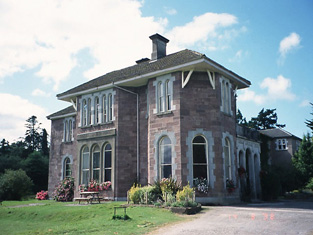
|
| Aghadoe Cottage | Archdeacon Forester was leasing Aghadoe Cottage from the Headley estate at the time of Griffith’s Valuation when it was valued at £7 10s. Bary states that it was built by the Archdeacon in 1838 though the Ordnance Survey Name Books mention him as being in residence there before that. It is still extant and is now run as Killeen House Hotel. See www.killeenhousehotel.com |
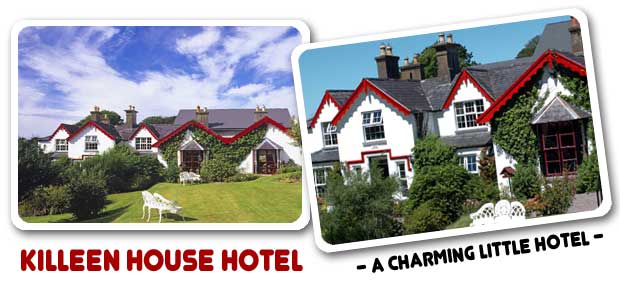
|
| Gortroe Lodge | At the time of Griffith’s Valuation, Gortroe Lodge was being leased by John Morrogh Bernard from John C.O’Riordan when it was valued at £22. Lewis records Gortroe Lodge as the seat of S. Riordan. Bary states that, according to John O’Donovan, Stephen Riordan built Gortroe Lodge in 1831. The house is now demolished and much development has taken place in the area. | |
| Grenagh House | Denis Lawlor was leasing Grenagh House from Henry Herbert’s estate at the time of Griffith’s Valuation when it was valued at £23 15s. Lewis mentions Grena as the seat of John O’Connell in 1837. The Ordnance Survey Name Books indicate that it was built by Mrs. Delaney in 1792. Bary states that O’Connell was obliged to leave the house due to debts. It then came into the possession of Denis Shine Lawlor and later again, Daniel James. It was afterwards the property of the O'Connor family but has been ruinous since the mid twentieth century. | |
| Caherdean House | Charles Daly was leasing Caherdean House from Henry Herbert at the time of Griffith’s Valuation, when it was valued at £11 10s. Bary suggests that the Lawlors may have had connections with Caherdean House around 1800 but later in the 19th century the Herberts were the landlords. The house is still extant and part of a large farm. . |

|
| Royal Victoria Hotel | Christopher Gallway was leasing this property to Thomas Finn at the time of Griffith’s Valuation, when it was valued at £65. This appears to be the Royal Victoria Hotel. In the early 1940s the Irish Tourist Association Survey noted that the Victoria Hotel "once the finest hotel in the district" had been converted into a farmhouse "about 130 years" and that there was an expectation that it was to be converted into a golf clubhouse. The site is now occupied by the Castlerosse Hotel, opened in 1960. |
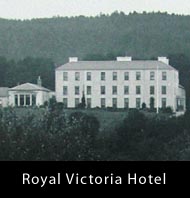
|
| Ballymalis | Christopher Gallway was leasing a property from John Sealy, which included a mill, at Ballymalis at the time of Griffith’s valuation. It was then valued at £34. It is labelled "paper mill" on the 1st edition Ordnance Survey map and as "woollen mill" on the 25-inch edition of the 1890s. An extensive range of buildings still exists at the site. Elsewhere in this townland is Ballymalis Castle, a tower house in existence since the sixteenth century and latterly, associated with the Eager family. | |
| Lakeview | At the time of Griffith’s Valuation, James O’Connell was leasing the property from the Herbert estate when it was valued at £13. Lewis calls the house Lakeville in 1837. Leet also mentions a house called Lakeville in 1814 which he refers to as the residence of Francis Russell. Bary states that the existing house was built by James O’Connell in 1870 after he was made a Baronet but that there was an earlier house here also. The latter is mentioned as the residence of Mr. O'Connell in the Ordnance Survey Name Books of the 1830s. It was built in 1740 and located in the southern end of the townland. In 1894 Slater refers to Lakeview as the residence of Sir Maurice J. O'Connell. The house is still extant. |

|
| Ballydowny | Bary states that "Ballydowney is a very old house, probably built in the early 18th century. It was the house in which Robert Emmet, the patriot hanged in Dublin in 1803, was born. His mother was Elizabeth Mason". The Ordnance Survey Name Books record that the proprietor, St. John Mason, had leased the townland to Richard McGillycuddy in the 1830s. By the time of Griffith’s Valuation, the house was valued at £4 and being leased by Charles Daly from Daniel Cronin. In the early 1940s, the Irish Tourist Association Survey also refers to the possible association with Robert Emmet though it indicates that this story may refer to an earlier house, "replaced by the present one, built about a hundred years ago". In 1942 it was occupied by a Mr. Blanchfield and is still extant. | |
| Belview House | Arthur Mahony was leasing a property valued at almost £4 from the Kenmare estate at the time of Griffith’s Valuation. In 1906 it was part of the Kenmare estate and valued at £5 5s. Bary states that this house, very close to the lake shore, was built by James Mahony, of the Dunloe Castle family, in the latter half of the 18th century. In the 1930s, it was still part of the Kenmare estate and Lord Castlerosse supervised the building of Killarney Golf Club here. The original house was demolished to make room for a new clubhouse. | |
| Dromadeesirt Cottage | Catherine Thompson was leasing a property valued at £5 from the Earl of Kenmare’s estate at the time of Griffith’s valuation. Bary states that this family may have been agents for Lord Kenmare and that local tradition suggests Mr. Thompson was killed by being gored by his bull. The property was occupied until the late twentieth century and farm buildings are still extant at the site. | |
| Killeen House | Denis Leary was leasing a house valued at £7 10s from the Earl of Kenmare’s estate at the time of Griffith’s Valuation. A farm is still extant at this site. | |
| Knocknamucklagh House | Charles Daly was leasing this property from the Kenmare estate at the time of Griffith’s Valuation, when it was valued at £5 10s. Bary indicates that this is a very old property, possibly built by the Fitzgeralds in the early 18th century when they were Kenmare’s tenants here. By the middle of the 19th century the Daly family were occupying the property which is still extant. | |
| Knockaneacoolteen House | William Curtayne was leasing this house from Lord Kenmare’s estate at the time of Griffith’s Valuation, when it was valued at £4 10s and stood on over 300 acres. Bary indicates that the house, possibly built in the 18th century, is still extant. | |
| Churchtown | At the time of Griffith’s Valuation, Sir A. Blennerhassett was leasing Churchtown House to Robert Stokes. In 1837 Lewis refers to it as the seat of Sir A. Blennerhassett. Leet mentions it as the residence of R.A. Blennerhassett in 1814. The house was valued at £31. Churchtown House is still extant. Much of the demesne is now part of Beaufort Golf Course. |
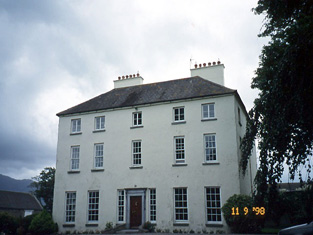
|
| Beaufort | Reverend Edward Day was in possession of the house at Beaufort at the time of Griffith’s Valuation when it was valued at £37. Lewis refers to it as the seat of Frederick W. Mullins in 1837. In 1814 Leet also refers to it as the residence of Reverend F. Mullins. In 1786 Wilson refers to Beaufort as the seat of Hon. Dean Crosbie. Various sources, including Bary, indicate that it was built on the site of a tower house known as Short Castle. . It was sold by the Mullins estate in the mid nineteenth century to the Day family who sold it again in the 1880s. Referred to by Slater in 1894 as the seat of Lt-Col. E. Nash Leahy. It is still extant and occupied. |

|
| Cullenagh House | At the time of Griffith’s Valuation, Cullenagh House was occupied by Kean Mahony when it was valued at £22. Lewis records it as the seat of Kean Mahony in 1837 as does Leet in 1814. In 1906 it was the property of Thomas McDonagh Mahony and valued at £18. Bary states that this house was probably built by the Mahonys towards the end of the 18th century. It was still extant but uninhabited towards the end of the twentieth century. | |
| Cullenagh Lower | Myles Mahony was occupying a house at Cullenagh Lwr at the time of Griffith’s Valuation. It was valued at £6 and part of a holding of 176 acres. The house is not shown on thre 25-inch Ordnance Survey map of the 1890s. | |
| Dunloe Castle | At the time of Griffith's Valuation, Daniel Mahony was leasing Dunloe Castle from Thomas H. Broderick when it was valued at £15. Lewis describes it as formerly the seat of the O’Sullivan family but in 1837 the residence of D. Mahony. Leet refers to it as the residence of Daniel Mahony in 1814. Wilson, writing in 1786, mentions Dunloe Castle as the seat of Gustavus Crosbie. In 1894 Slater refers to it as the seat of John Mahony. The Irish Tourist Association surveyor notes that this property has associations with the United Irishmen and states that, in the early 1940s, it was owned by Agnes Petitt. Bary states that it remained in the Mahony family until the mid-20th century. The castle itself is now a ruin, located in the grounds of the Dunloe Castle Hotel. | |
| Gortnaskarry House | At the time of Griffith’s Valuation, Michael Horgan was leasing a property at Gortnaskarry valued at £5 from the representatives of Denis Mahony. Bary speculates that it may once have been an inn. It is still extant. | |
| Gortnaskarry Cottage | Colonel Drummond was leasing a property valued at almost £5 to John Breen at the time of Griffith’s valuation. It is labelled Gortnaskarry Cottage on the 1st edition Ordnance Survey and remains by this name on subsequent editions.A house and farm are still extant at the site. | |
| Annadale | Lewis refers to Anadale as the seat of C. Colter in 1837. At the time of Griffith’s Valuation, Henry Blennerhassett was leasing a house at Annadale, parish of Killorglin, valued at £11 10s from a Mr. Thompson. Bary states that this is likely to be Peter Thompson whose wife was a Blennerhassett. The house is still extant though possibly not inhabited. | |
| Molahiffe House | Eliza Griffin was the lessor of this property at the time of Griffith's Valuation, when it was valued at almost £6 and vacant. In 1837 Lewis mentions "Boucheens" as the residence of Montague Griffin. Bary states that this is a very old house and is widely believed to be one of the earliest homes of the Browne family, later Lords Kenmare. It is still extant and occupied. |
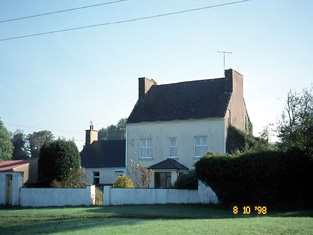
|
| Cloonlara | Christopher Gallway was leasing this property to William Hickson at the time of Griffith's Valuation, when it was valued at £7 5s. A farm is still extant at the site. | |
| Corbally House (Magunihy) | The Kenmare estate was the lessor of Corbally House at the time of Griffith's Valuation, when it was valued at £11 5s. Bary states that this farm was originally held by the O'Connor, probably of nearby Fieries Castle. Later a Fr. Dunne built Corbally House as a presbytery near the old Catholic Church. The property is still extant and occupied. | |
| Inchinveema | Christopher Gallway was leasing this property to Daniel Sullivan at the time of Griffith's Valuation, when it was valued at £6. Buildings are still extant at the site. | |
| Knocknaman | Henry Denny was leasing a property valued at £9 to William Thompson at the time of Griffith’s Valuation. An uunamed house, surrounded by trees, is marked on the 1st edition OS map. There is no house at this site now. | |
| Nunstown | Robert Leeson was leasing a property valued at £5 to Michael Barrett at the time of Griffith’s Valuation. A substantial farm still exists at the site. | |
| Ballyhar House | In 1786 Wilson refers to Ballyhar, the residence of Mr. Eager. John Leahy was in possession of this property at the time of Griffith's Valuation when it was valued at £17. Bary states that this house was originally built by the Eager family but later sold to the Leahys. It is now a ruin. | |
| Riverville (Currans) | Charles Blennerhassett held this property in fee at the time of Griffith's Valuation, when it was valued at £9 15s. Lewis records Riverville as the seat of Richard Marshall in 1837. The Ordnance Survey Field Name Books record Riverville as the residence of Richard Marshall c.1840, describing it as "a thatched house of oblong shape". Bary states that the house was a seat of the Marshell family and believed to have been built by them in the eighteenth century. They remained there until the 1840s. Later in the nineteenth century it was associated with the Spring family It is still extant and occupied. | |
| Abbeylands or The Abbey | Abraham Huggard was leasing this property from Sir William Godfrey at the time of Griffith's Valuation when it was valued at £5 10s. Local sources suggest it was built by the Huggard family in the early nineteenth century. It is still extant and occupied. | |
| Kilburn House | Edward Godfrey was leasing Kilburn House to John W. Bonner at the time of Griffith's Valuation, when it was valued at £11 5s. Bary states that this property was owned for much of the nineteenth century by Reverend William Godfrey and his wife, Lucy Day but was usually let to a tenant. The property is still extant and now a farmhouse B&B run by the Leane family. See www.stayatkilburn.com |
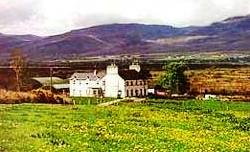
|
| Kilcolman Abbey | Kilcoleman Abbey was the residence of Sir William Godfrey at the time of Griffith's Valuation, when it was valued at £33. Lewis also records it as his residence in 1837. In 1894 Slater referred to it as the seat of Sir John F. Godfrey. In 1906, it was still part of the Godfrey estate and valued at £35 10s.The Irish Tourist Association survey of the early 1940s refers to it as "Godfrey House, a fine type of Elizabethan type mansion". Bary states that the original house, built by the first Godfrey to settle in the area at the end of the seventeenth century, was called Bushfield but that it burned down in 1774 though Wilson still refers to it by this name in 1786 and provides a detailed description of the surroundings. Knightly indicates that a new house was then built by Sir William Godfrey. This house was remodelled twice in the nineteenth century. Sir William Maurice Godfrey sold Kilcoleman in the 1960s and it was demolished in 1977. |
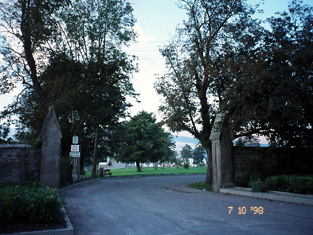
|
| Rathpoge | At the time of Griffith's Valuation, Sir William Godfrey was leasing this property to William Hickson. No house is marked in this area on the Ordnance Survey map, the only buildings being the Kilcolman farmyard. The buildings on the site were valued at £13. It was still in the possession of the Godfrey estate in 1906 with the same valuation but are no longer extant. | |
| Glen Ellen (Kilcolman) | James Godfrey was leasing this property from Lord Monteagle's estate at the time of Griffith's Valuation, when it was valued at £11 10s. Bary indicates that it was in the possession of a branch of the Godfrey family up until the end of the nineteenth century when it was then sold to the Huggard family. Slater notes it as the residence of Jn. T. Huggard in 1894. It has had several owners since then but is still extant and occupied. | |
| Reeks View | Rev. William de Moleyns was leasing this property from Lord Ventry's estate at the time of Griffith's Valuation, when it was valued at £4 15s, on a holding of 140 acres. It appears on the 1893 edition of the Ordnance Survey map as Reeks View. It is still extant. | |
| Anna | Sir William Godfrey was leasing this property to Cornelius Murphy at the time of Griffith's Valuation when it was valued at £10 5s. Lewis records it as the residence of Reverend O'Connor, PP, in 1837. In 1814 Leet mentions Annagh as the seat of Giles Rae. Bary writes that it was built by the Godfreys in the eighteenth century and was lived in by various members of that family until the early nineteenth century when it was occupied by tenants. It was tragically burnt to the ground in the late twentieth century. Sir William was leasing a second property in this townland to Willam R. Burke, valued at £8 10s. | |
| Laharan House | Sir William Godfrey was leasing this property to James O'Neill at the time of Griffith's Valuation, when it was valued at £7 5s, and part of a holding of 170 acres. It was recorded as the seat of F. Walker by Lewis in 1837 and Leet in 1814 as the seat of Francis Walker. Bary states that it was built by Francis Walker in 1808. The house passed to the Cronin family in the 1880s. It is stil extant and occupied. | |
| Cloonalassan House | Lord Monteagle was leasing this property to John Giles at the time of Griffith's Valuation, when it was valued at £8 5s, on a demesne of 123 acres, some of which extended into Ballycrispin townland. Lewis mentions, in 1837, that Ballycrispin was formerly the residence of the Spring-Rice ancestors. It is not shown on the later 25-inch Ordnance Survey map of the 1890s. | |
| Meanus House (Kiltallagh) | Lady Anne Headley's estate was leasing this property to Charlotte Walker at the time of Griffith's Valuation, when it was valued at £9 15s. Bary writes that it was leased by the Winn estate in the early part of the nineteenth century to the Walkers and later to the Spring family. It is still extant and was renovated in the twentieth century. |
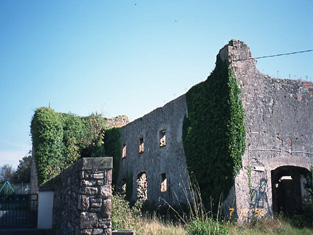
|
| Kiltallagh Glebe | Rev. Brownrigg (or possibly Browning) Drew was in possession of Kiltallagh Glebe at the time of Griffith's Valuation, when it was valued at £17. Lewis records it as the seat of Rev.J. Murphy in 1837. In 1786 Wilson refers to "Menus"as the house of Dr. Drew but he also refers to a residence of Rev. Dr. Day, near Kiltalla church. Bary mentions that it was renovated by Rev. Murphy earlier in the nineteenth century. It was also associated with the Day and Godfrey families. In 1920 it was sold to the Boyle family by the Representative Church Body and is still extant and occupied. | |
| Tomies | In 1837 Lewis mentions Tomies as the seat of D.J. O'Sullivan. At the time of Griffith's Valuation, the property, valued at £5, was being leased by Daniel O'Sullivan from the Herbert estate. Bary states that this house was more usually associated with the O'Donoghue estate, citing references to "O'Donoghue of Tomies" in the local press. In 1906 Lord Ardilaun owned the property at Tomies East valued at £8 15s. It is now in ruins. | |
| Fahagh Court | In 1786 Wilson mentions Fagha as the seat of Mr. Falvey. At the time of Griffith's Valuation, Daniel Buckley was leasing this property from John Morrogh Bernard, when it was valued at £3 10s. In 1906 Bertram Morrogh Bernard owned this property, then valued at £25. A house built n the later nineteenth century, it is labelled Fahagh Court on the 25-inch Ordnance Survey map of the 1890s. In 1943 the Irish Tourist Association survey noted that it had been extensively reconstructed and modernised and "bears little resemblance to the historic residence of the Morrogh-Bernards and before them the O'Flavey clan". It was then occupied by the Reynolds family. Bary states that the property became a hotel in the twentieth century before being damaged by fire. The extensive yard complex has now become the Killarney Country Club and holiday accommodation. |

|
| Currans House | The Ordnance Survey Name Books record Currans House as in a "decayed condition" in 1840. It was allegedly built c.1700. Francis Peet had resided there until c.1829. At the time of Griffith's Valuation, it was in the possession of Charles Daly, unoccupied and valued at £3. It is labelled Currans House on both the 1st and 25-inch edition Ordnance Survey maps. A house is still extant at the site. | |
| Roxborough (Molahiffe) | Wilson, writing in 1786, refers to Roxborough as the seat of Francis Chute. At the time of Griffith's Valuation, the townland was part of the estate of Reverend George Chute and Roxborough House was occupied by a Mrs Kenny and valued at almost £7. It is still extant and used as a farmhouse. | |
| Prospect (Killarney) | In 1786 Wilson that a house named Prospect, one mile from Killarney, was the seat of Mr. Supple. The Ordnance Survey Name Books mention Prospect House as the residence of Thomas Browne in the 1830s. It seems to have become ruinous after this as only a gate lodge is mentioned in Griffith's Valuation and Prospect is now shown on the 25-inch Ordnance Survey map of the 1890s. | |
| Molahiffe Castle | At the time of Griffith's Valuation, Maurice de Coursey was leasing a property in the townland of Castlefarm from the Kenmare estate which had a valuation of almost £6. It is likely to have been the house labelled on both the 1st and later 25-inch edition Ordnance Survey Maps as Molahiffe Castle. The National Inventory of Architectural Heritage states that this house was built in the mid-eighteenth century. In 1943 the Irish Tourist Association Survey highlights the close links between Molahiffe and the Browne family, who, it says, resided in the area until the building of the first Killarney House. The remains of the original Molahiffe castle are located a short distance from the present house, now known as Castlefarm House. |
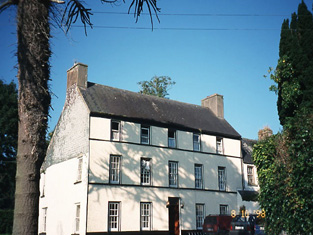
|

